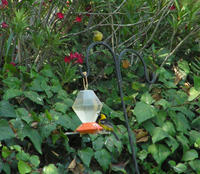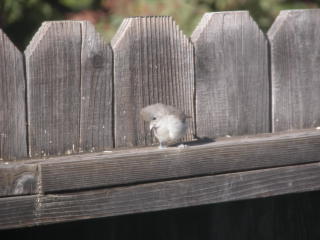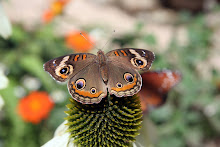Thursday, August 25, 2005
Wednesday, August 24, 2005
Tuesday, August 23, 2005
The Orioles are Moving On


I can tell that fall is getting close with the changes in the birds around the area. Even if the weather doesn't seem like it the birds sure know what the season is. Most of the adult Hooded Orioles have moved on. I don't think I have seen an adult male for over a week now. Harder to tell about the females as they look a lot like the youngsters. We still have quite a few of the young guys left though. They always hang out longer than the adults. Hey, talk about empty nesters wanting to Party!!!! Kids are out on their own and it is time for fun stuff! They don't even need to buy a RV!
They will head back up to our area around February of next year, raise a bunch of kids and then head back down for vacation. There are sometimes one or two that will stay in the area all year but I don't always see them every year. Most of them take off for warmer lands. I always look forward to seeing the first one of the season. They are such pretty birds. When they come back it is the breeding age males that come in first to stake out their territories so they are ready when the females make it in. They like to nest in the palm trees which we have several in the neighborhood.
In the small picture (click on it so you can see better) the female is on the top and male is down on the feeder. The larger picture is of a male. As in most all birds the female is fairly plain while the male gets lots of bright colors.
Wednesday, August 17, 2005
Grampa Pickles and the Hummers
Monday, August 15, 2005
Chumash Interpertive Center Hike
Kind of a quiet day as far as birds. We "saw" several up in the tree tops that we couldn't ID and heard several that we couldn't spot. We did get one life bird so it was a good day anyway. It is really nice over there. It opens up into the Lang Ranch Open Area. It is amazing how much open space we have around us here. There are so many places for us to go within a few miles of us.
- Scrub jay
- Black headed Phoebe
- White-breasted Nuthatch (lots of these around)
- Anna Hummingbird.
- California Towhee
- Spotted Towhee
- Bushtits
- Nuttall's Woodpecker (I thought we would see Acorns there but didn't. Heard alot more Woodpeckers then we saw though so they might have been there)
- Cactus Wren
- Titmouse (lots)
- Blue Gray Gnatcatcher (new to us) Cute tiny bird there was a whole flock of them in one tree on the upper trail.
- Cooper Hawk
- Mule Deer Okay, not a bird but.... Lots of ground squirrels too.
The Chumash Center wasn't open so couldn't go in there. I have never been in so I don't know what it is like. Doesn't look like it is used much but not sure about that. They do have a couple of outside areas with huts (don't remember what they call them) and some pow wow gathering areas. Interesting place.
Equestrian Center Birding 8/11/05
- Say's Phoebe
- Black Headed Phoebe
- Mourning Doves
- Crows Lots and Lots
- House Finches
- House Sparrows
- Mockingbird
- Scrub Jays
- Western SeaGull
- Juvenile Western Bluebirds (lots)
- Kestral
Friday, August 12, 2005
Thursday, August 11, 2005
News of the Weird

While I was out in the sunroom talking on the phone to Ron this morning I was feeding peanuts to 7 Scrubjays! That would be all of the family if I am correct in how I am figuring who is who.
We have the parents; JayJay and Mrs. Then we have the "Youngsters" ; the three offspring from the first nest this year. Then we have the two "Babies" from the last nest. Yes, I found out there are two not just the one I thought there was. In another month I won't be able to tell anyone apart! They were all taking peanuts off the ground in front of me and a couple took them from my hand. I think more would but there was so much going on it was a little stressfull!
A couple of them came up and sat on the back of the futon and "talked" to me for awhile. It was like they were "telling" on the other ones. I know, don't read human behavior into their actions! (I forget, what is that called?)
One of the youngsters took a peanut opened it up and ate part of it. Then he took half of the peanut that was left and brought it over to the sunroom and jumped on my foot that I had over the arm of the futon. He then "hid" the peanut under my shoelace!!!!! He then went off and got another peanut, guess he thought that was a great hiding place!
They have taken to "knocking" on the peanut containers to get our attention so we will open the containers and feed them! They aren't shy with us at all!!!

Later this afternoon I was back out in the sunroom reading when I heard some bird on the futon in back of me. I was in the middle of a sentence so wasn't really paying much attention but thought it was one of the jays. When I finished what I was reading I looked around to say Hi to the Jay and to get him a peanut but there was a baby Titmouse chirping at me!! He was about a foot from my face "begging" for food!! The parent was up in the lattice in back of me going crazy!! The parent finally got his attention away from me and he went up and started begging from her. Talk about surprised!! The Titmouse is normally pretty shy around me but this baby sure didn't know that! They are a tiny bird with a cute little tuff on their head. They take a sunflower seed from the feeder one at a time and then they go and eat it in the bushes. When they are done they come back for more. One at a time each time.
All in all a great day at Plymouth Gardens!
Wednesday, August 10, 2005
Birds seen in or from yard 8/9/2005

Here is the list of all the birds that I saw in the yard on Tuesday.
House Sparrow (many, many)
House Finch (again, too many to count)
Hooded Orioles
Black Headed Grosebeaks
Black Headed Phoebe
Crows
Cowbirds
Starlings
California Towhees
Spotted Towhee
Morning Doves
Lesser Goldfinches
White Breasted Nuthatch (one or maybe two)
Nuttall's Woodpecker
Black-chinned Hummingbird
Anna's Hummingbird
Allen's Hummingbird
Scrub Jays
Mockingbirds
Western Seagulls (seen flying over)
Turkey Vulture (seen flying over)
Another Hawk (most likely Redtail but didn't come close enough to tell)
Rock Dove (a flock of pigeons let out to fly from someones cage flying off by Windsor Drive)
Not bad for not leaving the house all day!
Sunday, August 07, 2005
Brown-Headed Cowbird

If a vote were taken tomorrow to find the most popular bird in the country, it's doubtful that the cowbird would win. That's because the cowbird has the nasty habit of laying its eggs in other birds' nests.
It all started back in the days when American Bison ruled the Great Plains. At that time a rather nondescript grayish or black bird followed the herds around, feeding on seeds in the abundant supply of buffalo excrement. Settlers on the plains came to calling these animals buffalo birds. But since the birds depended on wandering herds for food, they needed to wander as well if they wanted to survive. The problem, of course, is that wandering birds can't tend their nests. So the buffalo birds decided to leave their young in the care of other birds, an arrangement that seemed to work, at least from the buffalo birds' perspective. Then, during the 1800s, the prairies and buffalo disappeared, replaced by pasture and cattle. But the birds remained and started keeping company with cows instead of buffalo, eating insects in the grass, ticks on the livestock, and seeds and grain. The buffalo bird eventually became known as the cowbird.
A female brown-headed cowbird will watch potential host birds, such as song sparrows, chipping sparrows, phoebes, yellow and chest-sided warblers, and cardinals, as they build nests and begin laying their eggs. In the middle of the host's egg laying period, the female cowbird will sneak into the nest late in the afternoon, remove a host's egg, and then replace it with one of her own at dawn the following morning. Some hosts are hit more than once by cowbirds removing eggs and replacing eggs of their own.
The host birds, apparently unaware that one or more of their youngsters is an alien cowbird chick, will continue the rearing process. Sometimes, the cowbird chick grows faster than the host's own youngsters, and the larger chick may push the smaller chicks out of the nest. In the end, the host parents feed the baby cowbirds as if they were their own, and will protect them against predators until they are large enough to be on their own. From Enature.com
We get these birds around the house quite often. I can always tell they are around before I see them as they have a very high whistle that is very noticeableble. They hang out in in groups in parking lots like Costco with the Brewer's Blackbirds. I have never seen a baby cowbird getting fed by any other of the birds so I guess they don't bring them to the feeders before they are fully weaned or maybe I just haven't been looking at the right time.
Saturday, August 06, 2005
Migration
 There are several Black -Headed Grosbeaks in the yard now. There is often one or two off and on during the year but now there are at least 6 of them. I have seen three males but I haven't got a good picture of those yet. They are more colorful with the head being completely black and bright rust orange on their breast and body. (Halloween birds) The rest are either young males or females. I like their voice, to me it seems real "sweet" and soft. They have very large and strong beaks. (Grosbeaks!) Click on the picture and it will enlarge so you can see how heavy the beak is.
There are several Black -Headed Grosbeaks in the yard now. There is often one or two off and on during the year but now there are at least 6 of them. I have seen three males but I haven't got a good picture of those yet. They are more colorful with the head being completely black and bright rust orange on their breast and body. (Halloween birds) The rest are either young males or females. I like their voice, to me it seems real "sweet" and soft. They have very large and strong beaks. (Grosbeaks!) Click on the picture and it will enlarge so you can see how heavy the beak is. They are on their way down to winter in Mexico. I was reading that near Mexico City they eat a lot of Monarch Butterflies. They will eat for several days and then stop for a week or so. Experts think that it is because of the poison in the Monarchs. The birds have to stop so they don't build up too much in their systems.
I wonder what else we will be getting during the migration period. Hard to believe it getting on to fall already!
Thursday, August 04, 2005
New Kid on the Block

A new Jay has shown up the last few days. I thought for awhile it was one of the last set of babies acting a little "needy" by begging for food again. I got a good look at him this morning and it is a new baby. There is only one new one so most likely only one egg survived this time. With what it is costing me in peanuts maybe it is a good thing!! I could tell this one is young as it still has some of the pink on his beak. I guess they have the bright coloring so the parents can find their mouths easier! It isn't afraid of me as he was begging and checking out the peanuts out back right next to me while I was reading the paper this morning. He won't come up to my hand yet but he was "talking to me". No one seems to be feeding him so his parents must think he is old enough to go on his own. In fact Mrs. was half heartily chasing him away. She would make a dive bomb run at him when she came down but then left him alone. He did find a few bugs on his own and finally figured out how to crack open a peanut. I shelled a couple and threw them down and next time he came back he went for those first. I know, I know, spoiling him already!
Wednesday, August 03, 2005
Yard birds and off site too
The most noteable activity is the increase in Hummingbirds. Just this week it seems that the numbers have doubled! We are getting several Blackchinned Hummers along with the normal Anna's and Allens. I now have 14 necter feeders! Four of these are Oriole feeders that the hummers can use also.
The Hooded Orioles are out in force this year also. I have no idea how many are around but I have seen as many as 6 at the back feeder and 4 at the feeder at the side. Mostly young with half a dozen adults. The young males have their black chins already. It took them along time to come to the fountain in the front of the house but they are now coming in the morning for their baths. They seem to like to come in groups.




